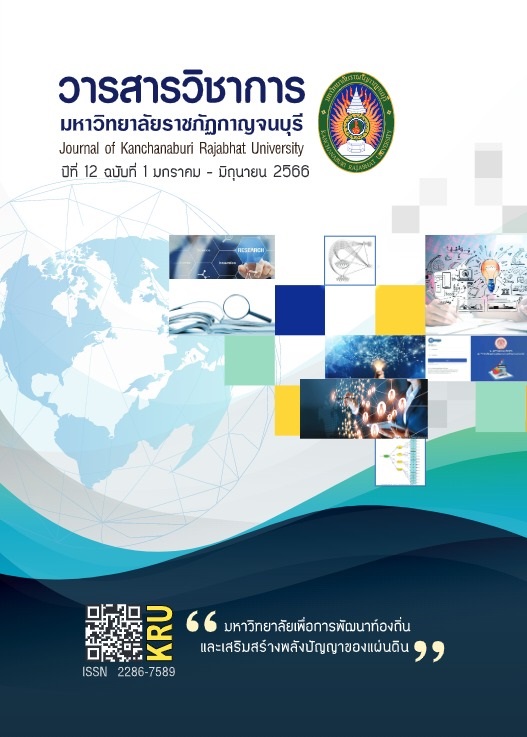A STUDY OF ACADEMIC ACHIEVEMENT IN WRITING AND SPELLING WITH A SCAFFOLDING TECHNIQUE OF PRIMARY 2nd STUDENTS.
Main Article Content
Abstract
The purposes of this this study are 1) to compare the achievement of the critical reading of Mathayomsuksa 6 students before and after studying with the 4Ex2 Instructional Model, 2) to develop the achievement of critical reading of Mathayomsuksa 6 students using the 4Ex2Instructional Model according to the specified criterion of not lower than the 75 percent, and 3) to study opinions of Mathayomsuksa 6 students towards the 4Ex2Instructional Model. The sample of this study, obtained from cluster random sampling, comprised 35students in Mathayomsuksa 6/2, Saiyokmaneekanwitthaya School, Sai Yok District, Kanchanaburi Province, in the first semester of the academic year 2022.
The research instruments were 1) Five critical reading learning management plans (2 hours for each plan with the total of 10 hours) using the 4Ex2 Instructional Model, 2) a 30-item critical reading ability test which assessed advanced thinking according to Bloom's Taxonomy theory, analytical thinking synthesis and valuation, and 3)a questionnaire on the opinions of students towards the 4Ex2Instructional Model. The statistics used to analyze the data comprised percentage, arithmetic mean, standard deviation (S.D.) and t – test dependent.
The findings revealed that:
1. The critical reading abilities of Mathayomsuksa 6 students after learning with the 4Ex2 Instructional Model were statistically significantly higher than before the learning the .05 level, and the critical reading abilities of Mathayomsuksa 6 students after learning with the 4Ex2 Instructional Model reached the criterion of 75 percent.
2. The students' opinions on the 4Ex2 Instructional Model was at the most agreeable level.
Article Details

This work is licensed under a Creative Commons Attribution-NonCommercial-NoDerivatives 4.0 International License.
References
กระทรวงศึกษาธิการ. (2552). การปฏิรูปการศึกษาของสำนักงานคณะกรรมการการศึกษาแห่งชาติ. กรุงเทพ: คุรุสภาลาดพร้าว.
นภาพรรณ ศรีถม. (2553). การพัฒนาแบบฝึกทักษะการเขียนสะกดคำในมาตราแม่กด สำหรับชั้นประถมศึกษาปีที่ 3. งานวิจัยการศึกษา สระแก้ว: โรงเรียนอนุบาลวังน้ำเย็น.
พิสมัย พรหมาชาติ. (2553). แบบฝึกทักษะการเขียนสะกดคำพื้นฐาน เรื่อง เรารักเมืองไทยของนักเรียนชั้นประถมศึกษาปีที่ 1. วิทยานิพนธ์การศึกษามหาบัณฑิต สาขาหลักสูตรและการสอน: มหาวิทยาลัยบูรพา.
วัฒนา เสนนอก. (2550). การใช้แบบฝึกเสริมทักษะทางภาษา เรื่องการเขียนสะกดคำตามมาตราตัวสะกดแม่กด. วิทยานิพนธ์ศึกษาศาสตร์มหาบัณฑิต สาขาจิตวิทยาการศึกษาพิเศษบัณฑิตวิทยาลัย: มหาวิทยาลัยศิลปากร.
วรรณี โสมประยูร. (2553). เทคนิคการสอนภาษาไทย. กรุงเทพฯ: สำนักพิมพ์ดอกหญ้าวิชาการ จำกัด.
ศิริพร ลิมตระการ. (2541). เอกสารสอนชุดวิชาภาษาไทย. กรุงเทพฯ: สำนักพิมพ์มหาวิทยาลัยสุโขทัยธรรมาธิราช.
สุดาพร สุธรรมวงศ์. (2543). การเปรียบเทียบผลสัมฤทธิ์ทางการเขียนสะกดคำ กลุ่มสาระการเรียนรู้ภาษาไทย ของนักเรียนชั้นประถมศึกษาปีที่ 2 ระหว่างการสอนโดยการใช้เกมและนิทาน. วิทยานิพนธ์ ค.ม. อุบลราชธานี: มหาวิทยาลัยราชภัฏอุบลราชธานี.
สุนันทา สายแวว. (2552). การพัฒนาแบบฝึกทักษะการเขียนสะกดคำที่ประสมสระลดรูป-เปลี่ยนรูปที่สะกดตรงมาตราตัวสะกด กลุ่มสาระการเรียนรู้ภาษาไทย สำหรับนักเรียนชั้นประถมศึกษาปีที่ 2. วิทยานิพนธ์ครุศาสตรมหาบัณฑิต: มหาวิทยาลัยราชภัฎอุบลราชธานี.
สุรางค์ โค้วตระกูล. (2541). จิตวิทยาการศึกษา. กรุงเทพฯ: จุฬาลงกรณ์มหาวิทยาลัย.
สุวัฒน์ วิวัฒนานนท์. (2550). การอ่านคิดวิเคราะห์และเขียน. กรุงเทพฯ: ซีซี นอลลิจลิงส์.
สนิท ดีเมืองซ้าย. (2552). การพัฒนารูปแบบการเรียนรู้ร่วมกันโดยใช้ปัญหาเป็นหลักที่มีการช่วยเสริมศักยภาพทางการเรียนผ่านเครือข่ายคอมพิวเตอร์. บัณฑิตวิทยาลัย ปรัชญาดุษฎีบัณฑิต (คอมพิวเตอร์): มหาวิทยาลัยเทคโนโลยีพระจอมเกล้าพระนครเหนือ.


